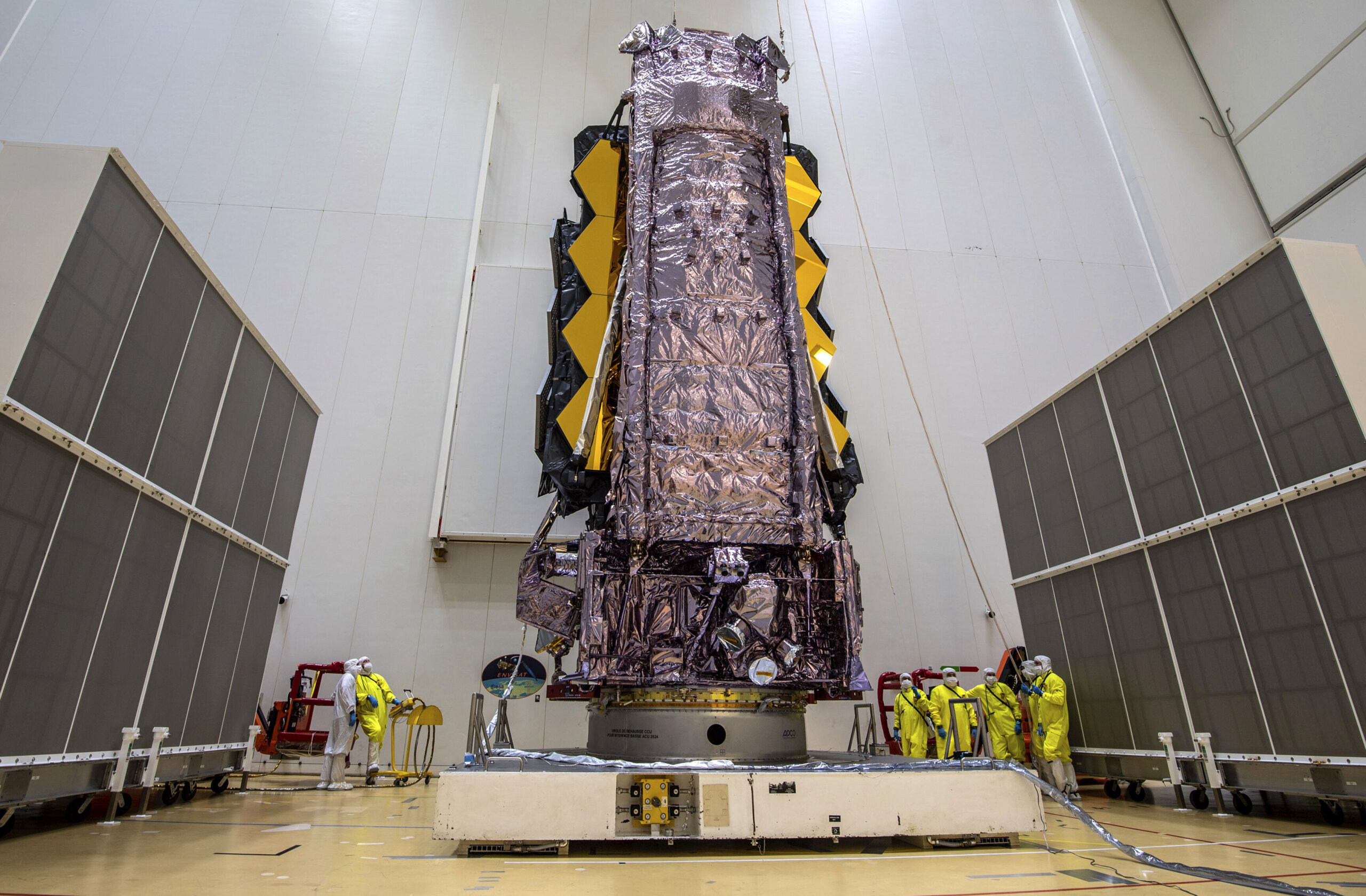
If all goes well, and that is by no means assured, a week from today, the $10 billion James Webb Space Telescope (JWST) is scheduled to finally launch over 30 years after it was first conceived.
The efforts of thousands of scientists, engineers and managers from NASA, the European Space Agency (ESA), the Canadian Space Agency (CSA) and JWST’s prime contractor Northrop Grumman, have gone into getting JWST to its launch pad at Kourou, French Guiana.
NASA announced today that the launch of JWST is now scheduled for Dec. 24, 2021, at 7:20 a.m. EST. JWST currently sits atop an ESA Ariane 5 rocket, a very reliable heavy lift workhorse. All checks have been completed and JWST is all set for launch … the countdown clock is running. It is not an exaggeration to say that all involved in the building of JWST and the worldwide astronomical community that is so eager to use JWST, is probably feeling a mix of tension, anxiety and exhilaration as the moment to lift off approaches.
At the time JWST was being designed in the early 90’s, the Ariane 5 was the only rocket capable of launching the largest space telescope of its time to be built. JWST is so large it had to be designed so that it could be folded up to fit inside the payload fairing of the Ariane 5 and then unfold to full size once in space.
That, as you shall see, is no easy task. In contrast, the Hubble Space Telescope (HST) deployed April 24, 1990, from the Space Shuttle, has a more conventional telescope design with a single main mirror of 2.5 meters (100-inches) enclosed in essentially a telescope tube spacecraft that orbits the Earth at several hundred miles altitude.
JWST, on the other hand, is a very large telescope or more precisely an Optical Telescope Element (OTE) that rides on top of a fully-capable spacecraft bus comprised of the Electrical Power Subsystem, Attitude Control Subsystem, Communication Subsystem, Command and Data Handling Subsystem, Propulsion Subsystem and Thermal Control Subsystem.
JWST has 18 gold coated hexagon shaped Beryllium mirror segments that give the telescope an aperture of 6.5 meters (256-inches). A single mirror of that size is far too large to fit in the Ariane 5’s payload fairing so the telescope’s design had to incorporate two folding supports each holding three mirror segments that will unfold and lock into place next to the other twelve mirror segments that are stationary. The secondary mirror that will send the collected light from the 18 mirror segments to the four instruments mounted on the back of the telescope also has to be folded to fit.
Oh, and because JWST is designed to collect light that includes the infrared part of the spectrum, it must be cooled to about -380 degrees Fahrenheit so there is no heat from the telescope to overwhelm feeble light from hopefully the very first stars and galaxies to form in our Universe. You get to that seemingly impossible temperature by using a deployable tennis court-sized five layer sunshield and park your telescope-spacecraft 1 million miles from Earth at a point called L2. For a projected lifetime of five to hopefully ten years and perhaps even longer, JWST will never be exposed to light (heat) from the Sun, Earth and Moon because of the sunshield and L2 orbit.
Because of its folded design JWST must unfold in a very precise manner comprised of 344 separate actions that must be successfully completed on time and in proper sequence. It will take 30 days to get to L2 and a projected six month checkout that will prepare the super chilled telescope-spacecraft for science observations to begin. Summer 2022 is the projected timeframe for when JWST will achieve “First Light”, that magic milestone in every telescope’s existence, when it is first exposed to light from the Universe and an image obtained.
First Light for HST was a disaster as it was determined that the blurry images meant that the telescope’s mirror was incorrectly figured and could not focus to a sharp image. NASA has taken great care to avoid a similar occurrence by testing JWST’s optics in multiple ways to insure precise optical performance. In addition, unlike HST’s single primary mirror, JWST’s 18 mirror segments can be individually “attenuated” (moved) to achieve optimal performance.
To bring the developing story of JWST to our WTOP audience I applied for, and was among the individuals selected by NASA, to attend a two-day JWST Launch Media Access Event at the Space Telescope Science Institute (STScI) and JWST Mission Operations Center (MOC). I will conduct interviews, attend briefings, tour the MOC and watch the launch of JWST.
To provide you with the very latest on JWST developments WTOP will have a live blog I will be posting to so that you can follow Dec. 22-24. Our blog may be supplemented by live reporting as well. Photos, videos and commentary from the home of JWST operations will be special to share with our WTOP audience.
In the 30-plus years I have been following this story, never, in my wildest dreams, did I think, “Spending Christmas Eve with JWST is for me.”
Join me in witnessing a whole new era of highly anticipated astronomical discovery made possible by the James Webb Space Telescope. The things we will see and discover are expected to revolutionize our understanding of the Universe just like HST and every other major new telescope has done throughout the centuries starting with Galileo.
Stay tuned as it all starts when that countdown clock hits “0” and ESA lights that Ariane 5 candle.
See Greg’s previous stories on JWST:
- James Webb Space Telescope has 2 years until expected launch
- Excitement surrounds space telescope, Moon missions
- Launch of James Webb Space Telescope delayed until possibly 2020
- James Webb Space Telescope set for August voyage to launch site
Follow my daily blog at What’s Up The Space Place to keep up with the latest news in astronomy and space exploration. You can email me at skyguyinva@gmail.com.







